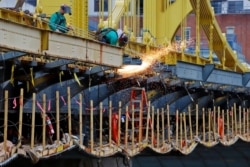U.S. infrastructure rates a C-minus grade, the American Society of Civil Engineers said Wednesday, with years of inaction by the federal government leaving the country with deteriorating roads and bridges while airports, water supplies and public transit systems need upgrades.
The civil engineers said the United States needs to spend $5.9 trillion over the next decade, about $2.6 trillion more than would normally be spent to bring its infrastructure up to a safe level.
The group said its infrastructure grade – barely passing in the U.S. academic system – reflected “significant deficiencies,” although a slight improvement from the D-plus grade in 2017, in part because of state and local government and private sector efforts to target repairs for water main leaks.
The engineers, however, said of the 17 categories making up the overall grade, 11 were in the D range that indicated a “significant deterioration” with a “strong risk of failure,” such as for public transit, storm water infrastructure, airports, roads and highways. It rated bridges, energy, drinking water and solid waste disposal at the C level, and just two areas – ports and rail service – in the B range.
Infrastructure spending is often debated in Washington, but seldom acted on, with successive administrations and lawmakers unable to agree on what infrastructure should be improved and how it should be paid for – out of normal government budgets or with higher taxes of some sort, such as gasoline taxes to build and repair roads.
During former President Donald Trump’s four years in the White House, his administration held many “infrastructure week” programs but there was never agreement with Congress on what projects to fund.
Now, President Joe Biden says he plans to tackle the issue following what he hopes is Congress’s passage of his $1.9 trillion coronavirus relief package.
It has already cleared the House of Representatives and could be passed in the Senate by mid-March.
But again, there is wide initial debate on what infrastructure projects should be funded and questions on how to pay for them.
Biden’s transportation chief, Pete Buttigieg, told the Associated Press that the civil engineers’ report card, “is a warning and a call to action. A generation of disinvestment is catching up to us, and we must choose whether to allow our global competitors to pull ahead permanently, or to invest in the safety, equity, resilience and economic strength that superior infrastructure can bring to Americans.”
He said that while communities throughout the U.S. fight the coronavirus pandemic, the Biden administration also is “committed to being a partner to help them save money, reduce congestion and improve mobility, safety and accessibility.”
The infrastructure issues came to the fore in February in the southwestern state of Texas, with its struggle to cope with power outages and water shortages during a prolonged winter storm. Frigid temperatures froze pipes that burst and flooded homes, while millions of residents lost heat and running water.










